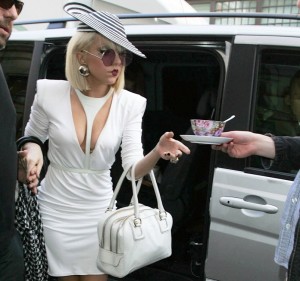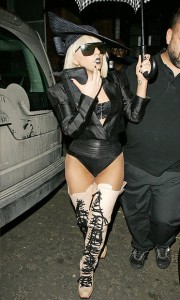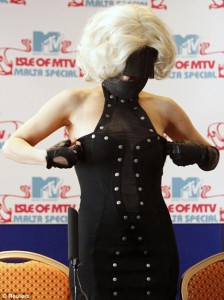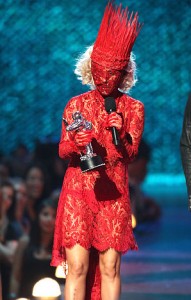Before she had an audience, it was just Gaga and her mirror. And for a while, it got weird. Four years ago, she was living on the Lower East Side of Manhattan, after leaving school and her parents’ financial support. In her shitty little apartment, she would order a bag of cocaine from a delivery service, get high, and work on her hair and makeup for hours. She’d get it perfect, and then come down from the coke and do it all over again.
—-Rolling Stone1Brian Hiatt, “New York Doll” in Rolling Stone. Issue 1080 (11 June 2009), 59.
”The biggest misconception about me is that I’m a character or a persona. That when the lights and cameras turn off, I turn into a pumpkin. It’s simply not true. I make music and art and design all day long. Yes, I wash my face and go to sleep but when I wake up, I am always Lady Gaga.”
—-Sydney Morning Herald2Andrew Murfett, “Lady Gaga” in Sydney Morning Herald (15 May 2009).
“Lady Gaga has been sent to Earth to infiltrate human culture one sequin at a time.”
—-“Transmission: Gagavision” from the weblog at LadyGaga.com

Lady Gaga arriving at London’s Radio One, 2009.
Over the last two years, a small young woman has appeared in popular culture, asserting her riddling persona in ways that have nearly every critic engaged. I have scrutinized hundreds of photographs of her, and I am still not sure precisely what she looks like off-duty, as it were, such is the extremity of her disguises. Her plainness (she lives on the border of beauty and not) gives her viewers the satisfaction of serious feeling (since her appeal is not universal) and gives her an immediate passkey to the world of High Art (her appeal is exclusive). Her extraordinary costumes, so nutty and witheringly chic, so embarrassing and fascist, so meticulous and creative, transform a quick dash from the limo to the television studio into performance art. You never see her photographed in jeans and a tee-shirt, or bouncing through Central Park in a track suit. Only recently has she hired a permanent stylist. Instead, she has an obscure group of helpers and designers called the Haus of Gaga, a place where I imagine that Sacha Baron Cohen’s Brüno mans the phones.

Lady Gaga in London, April 2009.
Lady Gaga is better than traditionally beautiful: she is genuinely riveting to look at. (As Karl Lagerfeld remarked about Anna Piaggi, elderly resident of the avant-garde and a revered editor at Vogue Italia: “She’s not pretty, she’s worse.”) It is a rare thing to get an unobstructed view of her face, which is covered in distracting makeup and decals, a collection of sunglasses of considerable antiquity or extraordinary construction, and scene-stealing hats and hairstyles (including hats made of hair). Appropriately, one of Gaga’s great heroes is the ultra-reclusive, ultra-fashionable Belgian designer Martin Margiela, a former assistant to Jean-Paul Gaultier, another Gaga icon. Maison Martin Margiela goes so far in its effacement of the perfect faces of its models that it often sends them down the runway veiled. Lately, the Maison has created the Islamic Revolution-esque censor bar sunglasses (“L’Incognito”), which cancel the eyes in a vaguely Star-Trekky way as much as they shield them. In the improbable setting of the 2009 Malta Music Week, Gaga met the press in a studded black dress, her face covered by a black S&M mask, which she called a “contemporary art piece”. Likewise, at the 2009 MTV Video Music Awards, Gaga sported a red Alexander McQueen crown with lace face mask.

